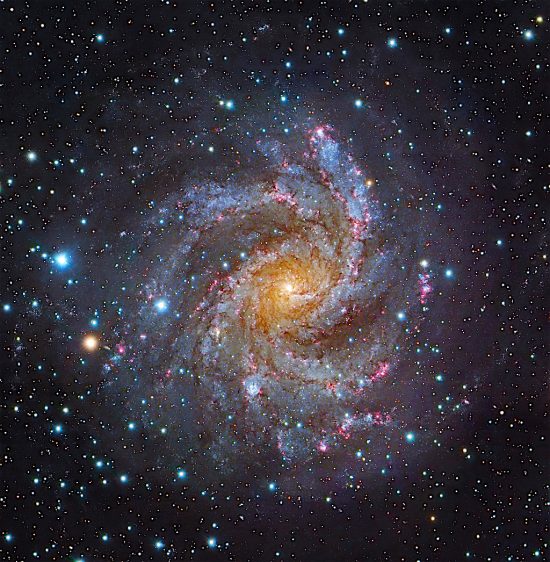
NGC 6946 the “Fireworks Galaxy”. Composite image credit: Subaru Telescope (NAOJ) and Robert Gendler.
May 31, 2017
Black holes are most likely electrical phenomena.
Black holes are the subject of many previous Picture of the Day articles. The short story, from an Electric Universe perspective, is that black holes are a misperception. The descriptive terminology used by researchers is problematic, relying on loose interpretations. Ambiguous lexical labels such as space/time, singularities, infinite density, and other non-quantifiable ideas, make what should be realistic investigations into a kind of irony.
Black holes are said to cause space and time to twist and warp so that velocity calculations yield impossible solutions. Matter inside of a black hole occupies no volume at all, yet retains gravitational acceleration so great that not even light can escape its attraction—thus they are “black” holes because they cannot be detected with optical telescopes.
According to a recent press release, a star 25 times as large as the Sun, “…should have exploded in a very bright supernova. Instead, it fizzled out…” the star was a “failed supernova.”
Black holes are actually an inferred phenomenon, since they cannot be detected by any instrument. Astrophysicists assume that matter can be accelerated and compressed by a black hole’s gravity. That forms the foundation for most conventional ideas about how galaxies behave, since it is commonly assumed that 98% of them contain supermassive black holes. Anomalous data is always forced into that theoretical framework or is consigned to the “mysterious” realm; scientific papers are filled with statements about “puzzlement” and “unexpected results”—just as the star, N6946-BH1 in the observed galaxy, NGC 6946.
Astronomers believe gravity is their only tool, and, in their world, no force can stop the collapse of any mass great enough to form a black hole. However, gravity’s effect is so small that it is effectively non-existent when compared to the electric force. It is charge separation that holds stars together, preventing their collapse. Even thermonuclear fires are not needed for a star to “live”. The standard model of stars fails because gravity is the wrong tool.
Using the concept of infinity is all over the work on black holes: infinitely weak gravity is compared to infinitely dense black holes. Such ideas mask the fact that no scientist understands gravity, or how mass is expressed by matter, or how matter expresses gravity. They especially ignore the Electric Universe.
Since stars are plasma phenomena, they are governed by electricity and not by gravity, alone. Since stars are loads in an externally powered circuit, a drop in circuit power means a drop in output, so a star will disappear—it enters a dark mode state. Variations in electric power mean variations in how a star behaves.
Stephen Smith
Hat tip to John Pescod












